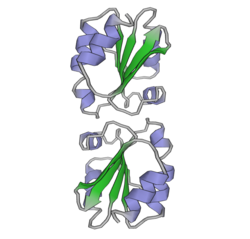Thioredoxin (TRX or TXN) is a class of small redox proteins known to be present in all organisms. It plays a role in many important biological processes, including redox signaling. In humans, thioredoxins are encoded by TXN and TXN2 genes.[5][6] Loss-of-function mutation of either of the two human thioredoxin genes is lethal at the four-cell stage of the developing embryo. Although not entirely understood, thioredoxin is linked to medicine through their response to reactive oxygen species (ROS). In plants, thioredoxins regulate a spectrum of critical functions, ranging from photosynthesis to growth, flowering and the development and germination of seeds. Thioredoxins play a role in cell-to-cell communication.[7]
- ^ a b c GRCh38: Ensembl release 89: ENSG00000136810 – Ensembl, May 2017
- ^ a b c GRCm38: Ensembl release 89: ENSMUSG00000028367 – Ensembl, May 2017
- ^ "Human PubMed Reference:". National Center for Biotechnology Information, U.S. National Library of Medicine.
- ^ "Mouse PubMed Reference:". National Center for Biotechnology Information, U.S. National Library of Medicine.
- ^ Wollman EE, d'Auriol L, Rimsky L, Shaw A, Jacquot JP, Wingfield P, Graber P, Dessarps F, Robin P, Galibert F (October 1988). "Cloning and expression of a cDNA for human thioredoxin". The Journal of Biological Chemistry. 263 (30): 15506–12. doi:10.1016/S0021-9258(19)37617-3. PMID 3170595.
- ^ "Entrez Gene: TXN2 thioredoxin 2".
- ^ Meng L, Wong JH, Feldman LJ, Lemaux PG, Buchanan BB (February 2010). "A membrane-associated thioredoxin required for plant growth moves from cell to cell, suggestive of a role in intercellular communication". Proceedings of the National Academy of Sciences of the United States of America. 107 (8): 3900–5. Bibcode:2010PNAS..107.3900M. doi:10.1073/pnas.0913759107. PMC 2840455. PMID 20133584.





